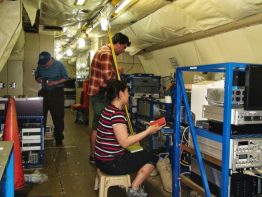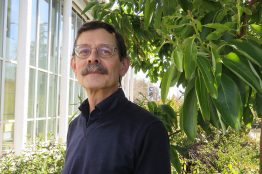As air quality improves, the invisible chemistry happening in the air around us is changing. Skies should clear up as emissions drop, but recent results suggested that declining nitrogen oxides can create an environment where airborne carbon-containing compounds more easily convert into small particles that harm human health. Regulators can now breathe easier. A University of Washington-led study, published in March in the Proceedings of the National Academy of Sciences, provides a fuller picture of the relationship between nitrogen oxides — the tailpipe-generated particles at the center of the Volkswagen scandal, also known as NOx, — and PM2.5, the microscopic particles that can lodge in lungs.
Read more at UW News »Bubble streams off Washington’s coast provide clues to what will happen during a major earthquake
Off the coast of Washington, columns of methane bubbles are being squeezed out of sediment and rising up through the water. A study by the University of Washington and Oregon State University suggests that the locations of these bubble plumes provide important clues to what will happen during a major offshore earthquake. Analysis of the underlying geology suggests that the bubbles emerge here because of the gas and fluid rising through faults which are generated by the motion of geologic plates—the same plates that produce major offshore earthquakes in the Pacific Northwest.
Read more at UW Today »Help share immersive learning experiences with all students at the college
As part of UW’s first annual Husky Giving Day, the College of the Environment is asking for your help ensuring all students at the College can engage deeply with their area of study through immersive outdoor learning experiences.
Read more »Gary Handwerk named director of UW Program on the Environment
The UW College of the Environment is pleased to announce that Gary Handwerk has been named director of the Program on the Environment (PoE), effective March 16, 2019. Gary is a scholar and teacher of the environmental humanities, working in the branch of literary and cultural studies known as “ecocriticism,” which aims to understand the effects of representations of nature. He has extensive experience in departmental administration, serving as chair of both Comparative Literature, and of English, over the last two decades.
Read more »Mystery of green icebergs may soon be solved
Research led by the UW’s Department of Atmospheric Sciences proposes a new idea that may explain why some Antarctic icebergs are tinged emerald green rather than the normal blue, potentially solving a decades-long scientific mystery. Most icebergs appear white or blue when floating in seawater, but since the early 1900s, explorers and sailors have reported seeing peculiar green icebergs around certain parts of Antarctica.
Read more at UW News »





